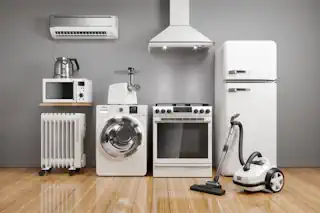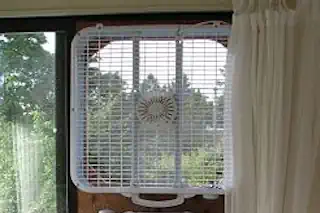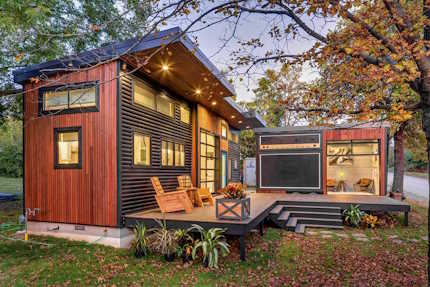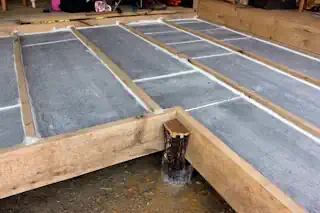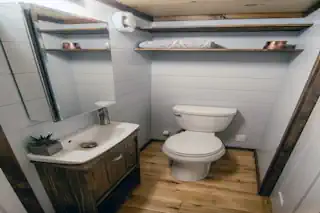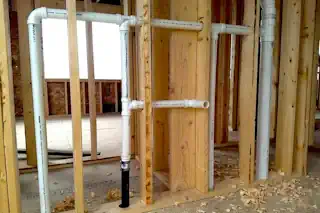Powering Your Tiny Home Efficiently: A DIY Guide to Off-Grid Living
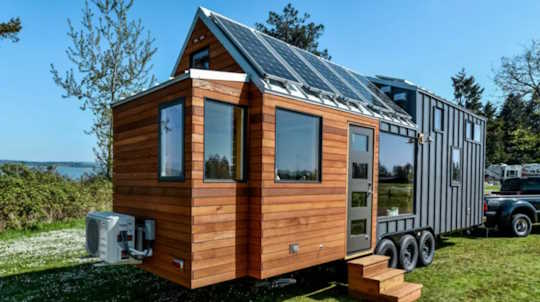
Living in a tiny home offers a remarkable opportunity to downsize your life, live more sustainably, and connect with the environment on a deeper level. However, this minimalist lifestyle comes with a unique set of challenges, particularly when it comes to powering your living space. Unlike traditional homes, tiny homes often operate off the grid, which means you’re responsible for generating your own electricity. This guide is for the environmentally conscious, DIY enthusiasts, and tiny home owners who are looking to power their compact dwellings efficiently. It navigates through the process of selecting, setting up, and maintaining a power system for your tiny home.
Assessing Power Needs in Your Tiny Oasis
Before you jump into the nitty-gritty of power generation, you must first understand how much electricity you consume. Living on off grid power is the dream for many but the off grid lifestyle is not for everyone. Power outages could be a common thing and planning for them will help balance out the off grid experience.
Calculating Your Consumption
Make a list of all the electrical appliances and devices you use and their associated power ratings, which are typically listed in watts on a sticker or in the manual. This will help you calculate your daily energy consumption in watt-hours by using the formula:
Watt-hours/day = power of the device (in watts) * hours of usage per day
When you have this data for all appliances and devices, you can add them up to get your total daily usage, which will guide your power system design. Regardless of whether you decide to use a solar setup, a battery bank, or gas generators be sure your energy sources can provide enough power for your basic needs and the occasional peak demand.
Factoring in Peaks and Troughs
Smaller systems in tiny homes will have limitations. Consider larger appliances like washing machines which might have a high start-up energy requirement. It’s best to space power-intensive activities throughout the day to avoid overwhelming your system.
Power consumption comes in two types, steady consumption and startup surges. Electric motors consume three times more electricity for a few seconds during startup. If the device usage isn’t continuous, note the average hours per day you use it but also triple the watts on the sticker as a guide for startup surges.
Seasonal Adjustments
Your power needs may change with the seasons. In the winter, you might require more power for heating, while summertime might see more demand from cooling systems.
By being conservative and efficient with your appliance use, you can dramatically reduce the size and cost of the energy production and storage you’ll need for your tiny home.
Choosing the Right Power Source for Your Tiny Houses
With your energy consumption profile in hand, it’s time to select a power source. There are several options to consider, each with their own pros and cons. Saving money is an important part of tiny house living but skimping on your power source is a mistake to not make.

Solar Power: Harvesting Energy from the Sun
Solar panels are a popular choice for tiny home owners due to their reliability, minimal maintenance, and silent operation. Solar power systems are a blend of solar panels and a battery bank. It is the battery bank that truly supplies the power. Solar panels are used to charge the batteries in most solar systems.
Panel Sizing and Positioning
Calculate the size of the solar array needed to meet your power requirements. You’ll also need to ensure your panels are installed in a location with maximum sun exposure throughout the day. Understanding the limitations of solar panel systems is key to ensuring proper sizing and placement.
System Components
A typical solar power system includes panels, a charge controller, batteries for energy storage, and an inverter to convert the stored energy into usable AC power.
Wind Power: Harnessing the Breeze for Electricity
For those in windier areas, a wind power turbine could be a complementary or alternative source of energy to solar power.
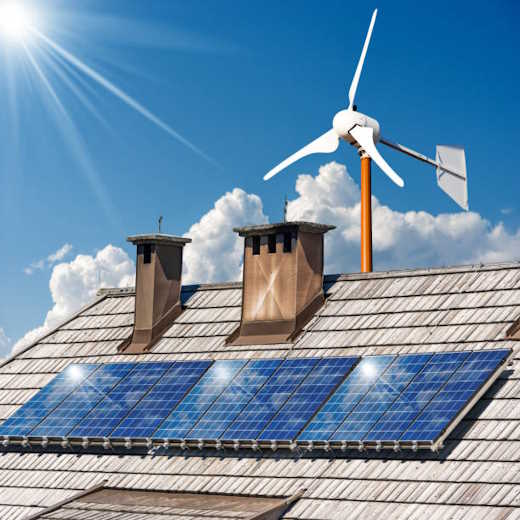
Site Suitability
A wind study will help determine if your location has enough consistent wind to make a wind power turbine worthwhile.
Synergy with Solar
The best setups often include both a solar system and a wind turbine system, as they can balance each other out in terms of power generation.
Generators: A Backup Plan
While generators are not as sustainable as solar or wind, they can be a practical solution, especially for periods of low sun or wind.
Fuel Considerations
Propane or gasoline-powered generators are common, but fuel availability and environmental impact should be factored in.
Syncing with Renewable Sources
Smart generators can be set up to turn on automatically when battery levels get low, providing a seamless transition between power sources.
Hybrid Systems
Some tiny homes employ hybrid power systems that combine two or more of the above sources. This provides more reliability and can cover a broader range of energy needs. There are a variety of alternative energy sources that are eco friendly, have a limited carbon footprint and make for great off grid systems.
Installing the Power System: Illuminating the Steps
Whether you’re opting for solar, wind, or a hybrid system, installation is a critical step that demands care and precision.
DIY vs. Professional Installations
Many tiny home enthusiasts opt for a DIY approach to save on costs, but it’s important to recognize when the job is too complex or potentially dangerous for an untrained individual. Especially when it comes to electrical work, there are strict safety codes to follow.
The Technical Bit
Technicalities vary depending on your chosen system, but there are some basic steps most installations will involve:
Installing solar panels or wind turbines securely
Connecting them to a charge controller
Wiring up your batteries and inverter safely
Connecting your electrical system to the inverter
Safety First
Always prioritize safety when working with any electrical elements. Wear the appropriate gear, work with a partner, and if you are unsure of anything, consult a professional.
Permits and Regulations
Before you install your system, ensure it complies with local regulations. This might include getting permits, having your system inspected, and meeting grid and safety standards.
Optimizing Power Usage in Your Tiny House
Now that your power system is in place, it’s time to make some lifestyle changes and adopt smart devices to use energy more efficiently.
Efficient Appliances and Lighting
Invest in energy-efficient and low-power appliances. LED lighting, for instance, can reduce lighting energy use by up to 80% compared to traditional incandescent bulbs.
Energy-Saving Habits
Small adjustments to your daily routines can add up to significant energy savings. Turning off lights and devices when not in use, line-drying clothes, and using power strips to completely disconnect electronic devices can all help.
Smart Technology Integration
Smart thermostats, energy monitoring devices, and programmable timers can assist in optimizing your energy usage.
Insulation and Passive Design
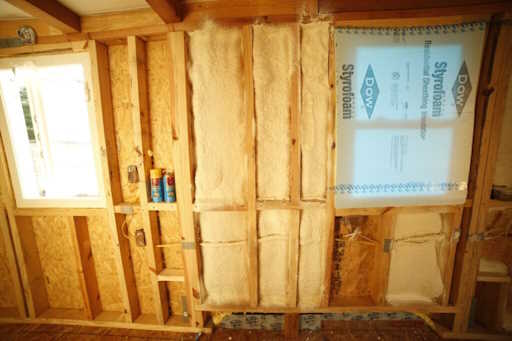
Well-insulated tiny homes with passive design features can reduce the need for heating and cooling, cutting down on energy use overall.
Maintenance and Troubleshooting: Nurturing Your Power System
Just as with any other component of your home, your power system will require maintenance to ensure it functions optimally and lasts a long time.
Regular Checks
Regularly inspect your panels, turbines, batteries, and all related equipment for signs of damage or wear.
Clean Energy
Keep solar panels and wind turbines clean to ensure they can capture as much energy as possible. This may mean cleaning them each season, but it depends on the local weather and environment.
Upkeep Lifestyles
Foster routines that support the longevity of your system, such as being mindful of battery use and only bringing in a backup generator when necessary.
Troubleshooting the Unknown
When something goes wrong, start with the basics. Check connections, confirm there’s been no interference with the system’s position, and ensure nothing has changed with the tolerances of your systems.
Professional Help
When in doubt, or if an issue is beyond your expertise, don’t hesitate to call a professional. They can diagnose problems and make repairs safely and efficiently.
Conclusion: A Sustained Approach to Tiny Home Power
By following the steps in this DIY guide, you’re well on your way to living comfortably in your tiny home with an efficient and reliable power system. Remember that sustainable energy doesn’t stop with the initial setup. It’s a lifestyle that requires continued assessment, adjustment, and appreciation of the energy we consume.
Feeling the sun on your solar panels or the breeze in your wind turbine can be a daily reminder of your connection to the natural world and to your energy independence. With patience and perseverance, off-grid living can offer a rewarding and fulfilling life that’s both kind to your wallet and to the planet we all call home.
Frequently Asked Questions (FAQs)
How much does it typically cost to set up a renewable energy system for a tiny house?
The cost can vary widely depending on the size of your home, the type of system you choose (solar, wind, hybrid), and whether you opt for professional installation or a DIY approach. Generally, you can expect to spend anywhere from a few thousand to tens of thousands of dollars.
Can I completely live off-grid with a tiny home power system?
Yes, many tiny home owners live completely off-grid by utilizing a combination of solar panels, wind turbines, and backup generators. However, successful off-grid living requires thoughtful planning, efficient energy use, and a willingness to adapt your lifestyle.
How often do renewable energy systems require maintenance?
While relatively low maintenance, it’s recommended to perform checks and cleanings at least once a season or more often depending on your local environment. This ensures your system operates efficiently and extends its lifespan.
Is it possible to connect my tiny home power system to the grid?
Yes, if local regulations allow it, you can connect your renewable energy system to the grid. This can provide backup power and even allow you to sell excess energy back to the grid, depending on your area’s policies.
Are there any incentives for installing renewable energy systems in tiny houses?
Many regions offer tax credits, rebates, or other incentives for installing renewable energy systems. Check with your local government or energy department for available programs.
How do I choose the right size system for my tiny home?
Assessing your energy needs is crucial. Start by listing all your appliances and their energy use, consider your lifestyle habits, and factor in your local climate. Consulting with a professional can also provide valuable insights into the best system size and configuration for your specific needs.
What’s the Best Way to Position Solar Panels for Maximum Efficiency?
Deciding on the optimal placement for your solar panels can significantly impact their efficiency and energy output. In the Northern Hemisphere, panels should ideally face true south, and in the Southern Hemisphere, true north, at an angle that matches your latitude for optimal year-round sun exposure. But there’s more to it than just direction – shading, tilt, and even the type of panel can affect your system’s efficiency. It’s a cozy thought, knowing that with a bit of knowledge and care, you can harness the sun’s power more effectively, making your tiny home that much brighter and warmer.
